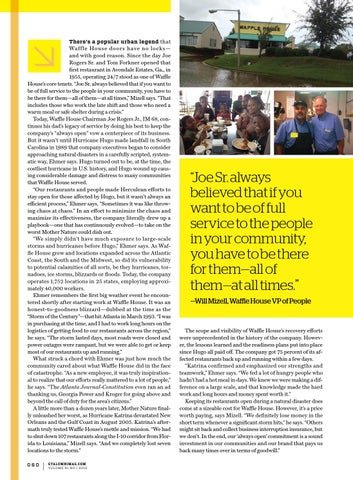There’s a popular urban legend that
Waffle House doors have no locks— and with good reason. Since the day Joe Rogers Sr. and Tom Forkner opened that first restaurant in Avondale Estates, Ga., in 1955, operating 24/7 stood as one of Waffle House’s core tenets. “Joe Sr. always believed that if you want to be of full service to the people in your community, you have to be there for them—all of them—at all times,” Mizell says. “That includes those who work the late shift and those who need a warm meal or safe shelter during a crisis.” Today, Waffle House Chairman Joe Rogers Jr., IM 68, continues his dad’s legacy of service by doing his best to keep the company’s “always open” vow a centerpiece of its business. But it wasn’t until Hurricane Hugo made landfall in South Carolina in 1989 that company executives began to consider approaching natural disasters in a carefully scripted, systematic way, Ehmer says. Hugo turned out to be, at the time, the costliest hurricane in U.S. history, and Hugo wound up causing considerable damage and distress to many communities that Waffle House served. “Our restaurants and people made Herculean efforts to stay open for those affected by Hugo, but it wasn’t always an efficient process,” Ehmer says. “Sometimes it was like throwing chaos at chaos.” In an effort to minimize the chaos and maximize its effectiveness, the company literally drew up a playbook—one that has continuously evolved—to take on the worst Mother Nature could dish out. “We simply didn’t have much exposure to large-scale storms and hurricanes before Hugo,” Ehmer says. As Waffle House grew and locations expanded across the Atlantic Coast, the South and the Midwest, so did its vulnerability to potential calamities of all sorts, be they hurricanes, tornadoes, ice storms, blizzards or floods. Today, the company operates 1,752 locations in 25 states, employing approximately 40,000 workers. Ehmer remembers the first big weather event he encountered shortly after starting work at Waffle House. It was an honest-to-goodness blizzard—dubbed at the time as the “Storm of the Century”—that hit Atlanta in March 1993. “I was in purchasing at the time, and I had to work long hours on the logistics of getting food to our restaurants across the region,” he says. “The storm lasted days, most roads were closed and power outages were rampant, but we were able to get or keep most of our restaurants up and running.” What struck a chord with Ehmer was just how much the community cared about what Waffle House did in the face of catastrophe. “As a new employee, it was truly inspirational to realize that our efforts really mattered to a lot of people,” he says. “The Atlanta Journal-Constitution even ran an ad thanking us, Georgia Power and Kroger for going above and beyond the call of duty for the area’s citizens.” A little more than a dozen years later, Mother Nature finally unleashed her worst, as Hurricane Katrina devastated New Orleans and the Gulf Coast in August 2005. Katrina’s aftermath truly tested Waffle House’s mettle and mission. “We had to shut down 107 restaurants along the I-10 corridor from Florida to Louisiana,” Mizell says. “And we completely lost seven locations to the storm.” 0 6 0
GTALUMNIMAG.COM VOLUME 91 NO.1 2015
“Joe Sr. always believed that if you want to be of full service to the people in your community, you have to be there for them—all of them—at all times.” —Will Mizell, Waffle House VP of People
The scope and visibility of Waffle House’s recovery efforts were unprecedented in the history of the company. However, the lessons learned and the readiness plans put into place since Hugo all paid off. The company got 75 percent of its affected restaurants back up and running within a few days. “Katrina confirmed and emphasized our strengths and teamwork,” Ehmer says. “We fed a lot of hungry people who hadn’t had a hot meal in days. We knew we were making a difference on a large scale, and that knowledge made the hard work and long hours and money spent worth it.” Keeping its restaurants open during a natural disaster does come at a sizeable cost for Waffle House. However, it’s a price worth paying, says Mizell. “We definitely lose money in the short term whenever a significant storm hits,” he says. “Others might sit back and collect business interruption insurance, but we don’t. In the end, our ‘always open’ commitment is a sound investment in our communities and our brand that pays us back many times over in terms of goodwill.”
